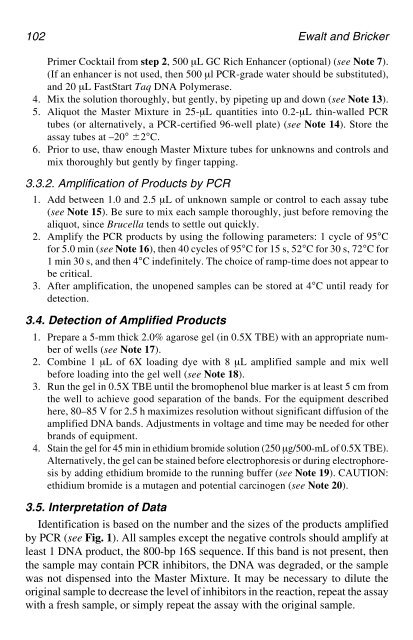PCR Detection of Microbial Pathogens PCR Detection of Microbial ...
PCR Detection of Microbial Pathogens PCR Detection of Microbial ...
PCR Detection of Microbial Pathogens PCR Detection of Microbial ...
Create successful ePaper yourself
Turn your PDF publications into a flip-book with our unique Google optimized e-Paper software.
102 Ewalt and Bricker<br />
Primer Cocktail from step 2, 500 µL GC Rich Enhancer (optional) (see Note 7).<br />
(If an enhancer is not used, then 500 µl <strong>PCR</strong>-grade water should be substituted),<br />
and 20 µL FastStart Taq DNA Polymerase.<br />
4. Mix the solution thoroughly, but gently, by pipeting up and down (see Note 13).<br />
5. Aliquot the Master Mixture in 25-µL quantities into 0.2-µL thin-walled <strong>PCR</strong><br />
tubes (or alternatively, a <strong>PCR</strong>-certified 96-well plate) (see Note 14). Store the<br />
assay tubes at –20° 2°C.<br />
6. Prior to use, thaw enough Master Mixture tubes for unknowns and controls and<br />
mix thoroughly but gently by finger tapping.<br />
3.3.2. Amplification <strong>of</strong> Products by <strong>PCR</strong><br />
1. Add between 1.0 and 2.5 µL <strong>of</strong> unknown sample or control to each assay tube<br />
(see Note 15). Be sure to mix each sample thoroughly, just before removing the<br />
aliquot, since Brucella tends to settle out quickly.<br />
2. Amplify the <strong>PCR</strong> products by using the following parameters: 1 cycle <strong>of</strong> 95°C<br />
for 5.0 min (see Note 16), then 40 cycles <strong>of</strong> 95°C for 15 s, 52°C for 30 s, 72°C for<br />
1 min 30 s, and then 4°C indefinitely. The choice <strong>of</strong> ramp-time does not appear to<br />
be critical.<br />
3. After amplification, the unopened samples can be stored at 4°C until ready for<br />
detection.<br />
3.4. <strong>Detection</strong> <strong>of</strong> Amplified Products<br />
1. Prepare a 5-mm thick 2.0% agarose gel (in 0.5X TBE) with an appropriate number<br />
<strong>of</strong> wells (see Note 17).<br />
2. Combine 1 µL <strong>of</strong> 6X loading dye with 8 µL amplified sample and mix well<br />
before loading into the gel well (see Note 18).<br />
3. Run the gel in 0.5X TBE until the bromophenol blue marker is at least 5 cm from<br />
the well to achieve good separation <strong>of</strong> the bands. For the equipment described<br />
here, 80–85 V for 2.5 h maximizes resolution without significant diffusion <strong>of</strong> the<br />
amplified DNA bands. Adjustments in voltage and time may be needed for other<br />
brands <strong>of</strong> equipment.<br />
4. Stain the gel for 45 min in ethidium bromide solution (250 µg/500-mL <strong>of</strong> 0.5X TBE).<br />
Alternatively, the gel can be stained before electrophoresis or during electrophoresis<br />
by adding ethidium bromide to the running buffer (see Note 19). CAUTION:<br />
ethidium bromide is a mutagen and potential carcinogen (see Note 20).<br />
3.5. Interpretation <strong>of</strong> Data<br />
Identification is based on the number and the sizes <strong>of</strong> the products amplified<br />
by <strong>PCR</strong> (see Fig. 1). All samples except the negative controls should amplify at<br />
least 1 DNA product, the 800-bp 16S sequence. If this band is not present, then<br />
the sample may contain <strong>PCR</strong> inhibitors, the DNA was degraded, or the sample<br />
was not dispensed into the Master Mixture. It may be necessary to dilute the<br />
original sample to decrease the level <strong>of</strong> inhibitors in the reaction, repeat the assay<br />
with a fresh sample, or simply repeat the assay with the original sample.






